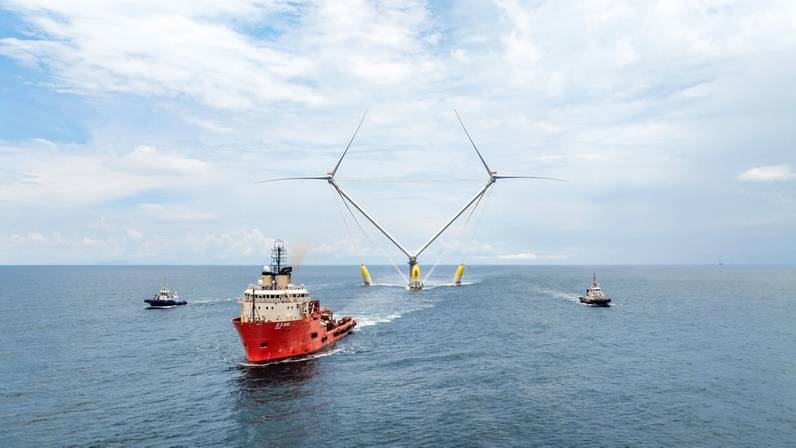
OceanX, which is reported by its developer MingYang Group to be the world's largest single capacity floating wind power platform, embarked on its journey from Guangzhou to the Yangjiang Mingyang Qingzhou IV offshore wind farm in Guangdong, China, a 191-nautical-mile, 50-hour tow.
This floating wind turbine platform is arranged in a 'V' shape and carries two 8.3 MW offshore wind turbines. With a total capacity of 16.6 MW, it can be used in a wide range of sea areas around the world with water depth of more than 35m.
OceanX impeller reaches 219m at its highest point and a maximum width of about 369m in the air. The whole wind turbine platform has a total displacement of 15,000 tons, and a towing draft of 5.5m. Once operational, it is expected to produce 54 million kWh annually.
The new floater pioneers the use of ultra-high performance concrete with a compressive strength exceeding 115 MPa for floating foundation construction, a material four times stronger than standard concrete, significantly enhancing load-bearing capacity. The floating foundation also uses a pre-stressed high-strength concrete assembly structure, facilitating modular and batched manufacturing.
According to the developer, OceanX also introduces a cutting-edge float design, using layered material to replace traditional steel or hybrid materials. The float lightens the floats and accommodates their curved form. The three streamlined ellipsoidal floats offer reduced wave resistance and enable lateral rotation, providing yawing power. Rigorous testing confirms that the streamlined shape strikes an ideal balance between stability and load-bearing.
Notably, housing two wind turbines on a single floating platform can significantly cut down the per-kilowatt cost, as well as reduce the required sea area and operational maintenance expenses. Mingyang's OceanX towing in progress, Guangdong Province, China. Image courtesy Mingyang
Mingyang's OceanX towing in progress, Guangdong Province, China. Image courtesy Mingyang
BIG DESIGN
OceanX's tower, with its elongated elliptical design, is designed to maximize wind exposure along its longer axis. Additionally, the towers are fitted with a dual-access system for lifts and ladders, ensuring the comfort and safety of personnel during ascent and descent. In addition to the evolution of the wind turbine form, Mingyang also expands the boundaries of the application of the cable-stayed system, installing it for the first time globally in a wind turbine.
OceanX has harnessed the spatial framework of its tower system, integrating what it says is the world's largest high-stress strand cable-stayed system. A network of 13 main and 6 auxiliary cables tensions the mainframe, tower, and floating foundation, establishing a stable tensioning mechanism across the wind turbine's components. This cable-stayed design has redefined the load transfer path of traditional wind turbines.
Instead of the tower bearing the full impeller and gravity loads, the system distributes the tower's gravity load to the tension cables, with the tower now only partially supporting the impeller loads. This strategic redistribution significantly lightens the tower's load, enabling a streamlined and lightweight structural design.
To integrate the 200-meter-long, 18-centimeter-diameter cables between the wind turbine, tower, and floats, OceanX employs a precise combination of graded pre-tensioning, multi-dimensional monitoring, and synchronized tensioning. This ensures that all 13 main cables achieve their individual pre-tensioning specifications and can be pre-tensioned to a maximum force of 350 tonnes, optimizing the structural integrity and performance of the wind turbine system.
In the face of extreme typhoon conditions, floating wind turbines must be designed to withstand 360° typhoon loads from the outset to ensure stability and safety. OceanX employs a single-point mooring system, which allows the platform to adaptively yaw with the typhoon's direction. This ensures that the wind turbine consistently faces the incoming wind, regardless of the typhoon's path.
In April 2020, the 1:10 scale prototype of the OceanX dual-rotor floating wind turbine platform was launched in Lake Quarry, Germany. By October, it had completed a two-month offshore operation in the Baltic Sea, enduring tests equivalent to 72m/s winds and 30-meter waves, and earned a feasibility certificate from DNV.